Julia Steiny: What Is International Restorative Justice Week?
Wednesday, November 20, 2013
Julia Steiny, GoLocalProv MINDSETTER™
Internationally, the Restorative Justice community set aside November 17-24 to celebrate the power of Restoration. Of the many sites offering resources on this topic, I recommend
Canada's, for a start.
But what is Restorative Justice?
Well, crudely, it's an alternative to the justice system we've got -- the one that now has about 2.2 million Americans behind bars at about $30,000 per inmate, per year. (Do the math.) Our punitive justice tends to ruin lives -- of the offender and their community -- and largely ignores the needs of the victims and their communities.
GET THE LATEST BREAKING NEWS HERE -- SIGN UP FOR GOLOCAL FREE DAILY EBLAST
By contrast, restorative justice works to salvage the lives of all parties, victims, offenders, their families and their larger community, to the extent possible. Restoration first caught fire in the late 1970s in New Zealand, and has since gone viral, permeating the judicial, social and educational systems of countries like Australia, Sweden, Norway and others. It's huge. We're lagging the developed world on this one.
To illustrate the distinction, I'll relate the stories of two youthful offenders, Aaron and Powhare. The stems of their stories are almost identical, until they slam into their respective countries' justice systems.
Aaron was from a small town in Vermont. When his parents divorced, he lived with his father. While he saw his mother occasionally, she did not have custody. When he was 15, she was killed in a motorcycle accident. The neighbors were fully aware that Aaron's father was emotionally abusing the boy, but did nothing. Who knows what the schools did or didn't know, but Child Protective Services were never engaged on his behalf. At 16, Aaron killed his father with a shotgun.
Powhare was from a small town in New Zealand. I'm guessing from his name that he's a Maori, an Aboriginal tribe that is a NZ minority group. Powhare's parents also divorced; he lived with Dad; mom was only nominally in the picture. The neighbors knew the father was abusing the boy emotionally and physically, but did nothing. Protective Services were never involved. Powhare killed his father with a shotgun at 14.
Their fates diverge with two radically-different justice systems.
Aaron faced America's retributive system, which asks:
* What rules or laws were broken?
* Who is to blame?
* How should they be punished?
Oddly, Vermont, alone among the states, has a hugely successful restorative juvenile-justice system, which cuts recidivism to single digits and incarcerates the smallest percentage of youth in America. (Massachusetts is 8th lowest; vengeful Rhode Island is 31 from the top.) However, Vermont law remands violent juvenile offenders into the adult system, where they get the punitive treatment.
Aaron pled guilty to second-degree murder to avoid a first-degree murder conviction. The Court sentenced him to 22 years. He now has a swastika tattoo and a mohawk, common efforts to signal toughness to ward off the assaults accepted as part of prison life. This is our idea of "justice."
The birth of Restorative Justice
In the late 1970s, the Maori elders demanded that the government stop incarcerating their kids at a disproportionally higher rate than White kids. Post-prison, young offenders returned home worse -- hardened, not accepting responsibility at all. Instead, the elders wanted the offender, victim and their families to participate in their traditional tribal circle. This evolved into "Family Group Conferencing," a model of restorative justice. All young offenders, of all races, are now offered FGC, although they can opt for conventional Court. The severity of Powhare's crime required his extended family to convince the Court of their commitment to supporting the boy's restitution.
Restorative justice is "victim-driven," focusing on repairing their harm, as much as possible, so the community can live together peacefully and safely. Using a formal conferencing process, the victim, offender, and their families work with social workers and police to devise a restitution plan on which they all must agree. To be eligible for FGC, the offender has to admit his guilt and take responsibility for his actions. Restorative systems ask:
* Who has been hurt?
* What are their needs?
* Who is obligated to address those needs, to make restitution, and to restore relationships and the community as a whole, as best as possible?
The face-to-face conference is generally quite emotional and painful.
As a result of his conference, Powhare submitted to intensive Court supervision for 2 years, during which he agreed to live with the extended family. He underwent a psyche assessment and counseling. The restitution plan forbade drugs, alcohol or access to firearms.
In the end, Powhare got an education and now works for the NZ forest service. Instead of incurring taxpayer costs for something he did at 14, he's a productive, contributing member of family, tribe, and larger community.
To my mind, both boys were themselves victims, but only one encountered a justice system able to tease out his circumstances. Restoration gave Powhare's life back to him. Retribution sent Aaron to prison, a place that turns inmates into primitive beasts, with infinitely reduced chances of making a decent life for themselves when they get out. Aaron was an abused kid. Could he have been saved? Our justice system doesn't bother to find out.
And people wonder why I'm such a nut for Restoration.
Julia Steiny is a freelance columnist whose work also regularly appears at EducationNews.org . She is the founding director of the Youth Restoration Project, a restorative-practices initiative, currently building demonstration projects in Rhode Island. She consults for schools and government initiatives, including regular work for The Providence Plan for whom she analyzes data. For more detail, see juliasteiny.com or contact her at [email protected] or c/o GoLocalProv, 44 Weybosset Street, Providence, RI 02903.
Related Slideshow: New England Communities With the Most Political Clout 2013
The Sunlight Foundation, in conjunction with Azavea, released data maps this week showing political contribution dollars to federal elections dating back to 1990 -- by county.
GoLocal takes a look at the counties in New England that had the highest per-capita contributions in the 2012 election cycle -- and talked with experts about what that meant for those areas in New Engand, as well as the candidates.
_400_395_90.jpg) View Larger +
View Larger +
Prev
Next
25. Merrimack County, NH
Contributions, per capita, 2012: $9.86
Total contributions: $1,447,713
Merrimack County is named after the Merrimack River and is home to the states capital, Concord. Merrimack County has a total area of 956 square miles and a population of 146,761.
 View Larger +
View Larger +
Prev
Next
24. Cheshire County, NH
Contributions, per capita, 2012: $9.88
Total contributions: $759,209
Cheshire is one of the five original counties in New Hampshire and was founded in 1771. The highest point in Cheshire County is located at the top of Mount Monadnock, which was made famous by the poets Ralph Waldo Emerson and Henry David Thoreau.
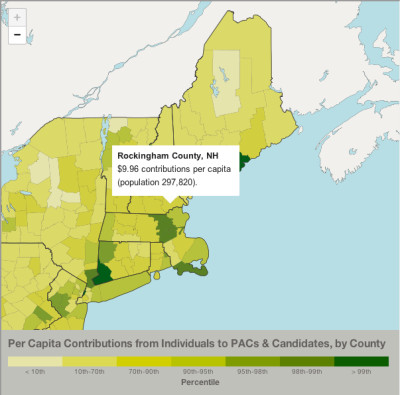 View Larger +
View Larger +
Prev
Next
23. Rockingham County, NH
Contributions, per capita, 2012: $9.96
Total contributions: $2,965,530
Rockingham has 37 communities and has a population of 297,820. Rockingham County also was home to the famous poet, Robert Frost
 View Larger +
View Larger +
Prev
Next
22. Belknap County, NH
Contributions, per capita, 2012: $10.02
Total contributions: $604,512
Belknap County is one of the ten counties in New Hampshire and has a population of 60,327. It is located in the center of New Hampshire and the largest city is Laconia.
 View Larger +
View Larger +
Prev
Next
21. Hampshire County, MA
Contributions, per capita, 2012: $10.41
Total contributions: $1,664,077
Hampshire County has a total area of 545 square miles and is located in the middle of Massachusetts. Hampshire County is also the only county to be surrounded in all directions by other Massachusetts counties.
 View Larger +
View Larger +
Prev
Next
20. Barnstable County, MA
Contributions, per capita, 2012: $10.90
Total contributions: $2,348,541
Barnstable County was founded in 1685 and has three national protected areas. Cape Cod National Seashore is the most famous protected area within Barnstable County and brings in a high amount of tourists every year.
 View Larger +
View Larger +
Prev
Next
19. Berkshire County, MA
Contributions, per capita, 2012: $12.49
Total contributions: $1,624,400
Berkshire County is located on the western side of Massachusetts and borders three different neighboring states. Originally the Mahican Native American Tribe inhabited Berkshire County up until the English settlers arrived and bought the land in 1724.
 View Larger +
View Larger +
Prev
Next
18. Essex County, MA
Contributions, per capita, 2012: $13.22
Total contributions: $9,991,201
Essex is located in the northeastern part of Massachusetts and contains towns such as Salem, Lynn, and Andover. Essex was founded in 1643 and because of Essex historical background, the whole county has been designated as the Essex National Heritage Area.
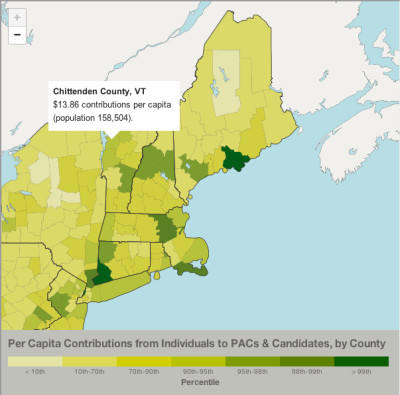 View Larger +
View Larger +
Prev
Next
17. Chittendon County, VT
Contributions, per capita, 2012: $13.86
Total contributions: $2,196,107
Chittenden has a population of 158,504, making it Vermont’s most populated county. Chittenden’s largest city is Burlington, which has about one third of Vermont’s total population.
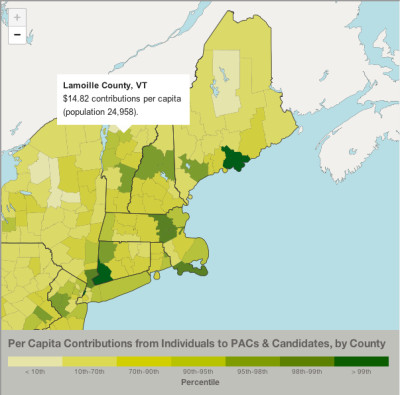 View Larger +
View Larger +
Prev
Next
16. Lamoille County, VT
Contributions, per capita, 2012: $14.82
Total contributions: $369,854
Lamoille County was founded in 1835 and has a population of 24,958. The county has 464 square miles, of which 461 of them are land.
 View Larger +
View Larger +
Prev
Next
15. Addison County, VT
Contributions, per capita, 2012: $15.49
Total contributions: $569,299
Located on the west side of Vermont, Addison County has a total area of 808 square miles. Addison's largest town is Middlebury, where the Community College of Vermont and Middlebury College are located.
 View Larger +
View Larger +
Prev
Next
14. Newport County, RI
Contributions, per capita, 2012: $16.02
Total contributions: $1,214,26
Newport County is one of the five Rhode Island Counties and was founded in 1703. Just like Connecticut, none of Rhode Island counties have an any governmental functions.
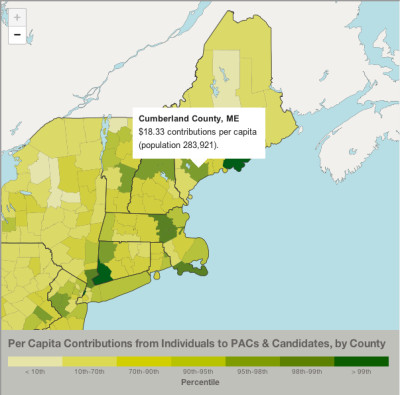 View Larger +
View Larger +
Prev
Next
13. Cumberland County, ME
Contributions, per capita, 2012: $18.33
Total contributions: $5,205,507
Cumberland County has a population of 283,921 and is Maine’s most populated county. The county was named after the William, Duke of Cumberland, a son of King George II.
 View Larger +
View Larger +
Prev
Next
12. Windsor County, VT
Contributions, per capita, 2012: $20.57
Total contributions: $1,156,149
Windsor County is the largest county in Vermont and consists of 971 square miles of land and 5 square miles of water.
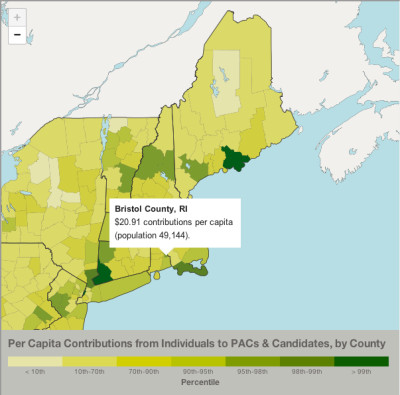 View Larger +
View Larger +
Prev
Next
11. Bristol County, RI
Contributions, per capita, 2012: $20.91
Total contributions: $1,027,472
Bristol County has a population of 49,144 and is the third smallest county in the United States. Bristol County was originally apart of Massachusetts, but was transferred to Rhode Island in 1746.
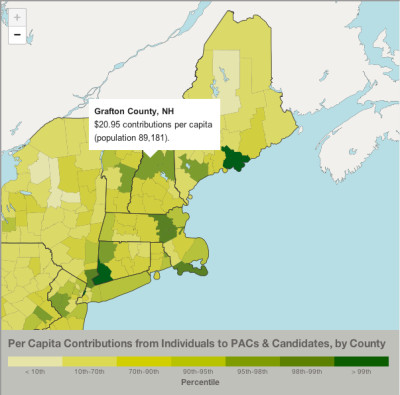 View Larger +
View Larger +
Prev
Next
10. Grafton County, NH
Contributions, per capita, 2012 :$20.95
Total contributions: $1,868,739
With a population of 89,181, Grafton County is the second largest county in New Hampshire. Home of New Hampshire’s only national forest, White Mountain National Forest takes up about half of Grafton’s total area
 View Larger +
View Larger +
Prev
Next
9. Carrol County, NH
Contributions, per capita, 2012: 2012: $22.81
Total contributions: $1,012,10
Created in 1840, Carroll County has a population of 47,567. Carroll County was also named after Charles Carroll, the last surviving signer of the United States Declaration of Independence.
 View Larger +
View Larger +
Prev
Next
8. LItchfield County, CT
Contributions, per capita, 2012: $22.86
Total contributions: $4,286,143
Although it is Connecticut’s largest county, Litchfield has the lowest population density in all of Connecticut. Since 1960 all Connecticut counties have no county government.
_400_395_90.jpg) View Larger +
View Larger +
Prev
Next
7. Middlesex County, MA
Contributions, per capita, 2012: $32.81
Total contributions: $50,432,154
Middlesex County has a population of 1,503,085 and has been ranked as the most populous county in New England. The county government was abolished in 1997, but the county boundaries still exists for court jurisdictions and other administrative purposes.
 View Larger +
View Larger +
Prev
Next
6. Nantucket County, MA
Contributions, per capita, 2012: $33.41
Total contributions: $344,021
Nantucket County consists of a couple of small islands and is a major tourist destination in Massachusetts. Normally Nantucket has a population of 10,298, but during the summer months the population can reach up to 50,000.
 View Larger +
View Larger +
Prev
Next
5. Norfolk County, MA
Contributions, per capita, 2012: $35.87
Total contributions: $24,459,854
Named after a county from England, Norfolk County is the wealthiest county in Massachusetts. As of 2011, Norfolk was ranked the 32nd highest income county in the United States.
 View Larger +
View Larger +
Prev
Next
4. Dukes County, MA
Contributions, per capita, 2012: $36.32
Total contributions: $618,960
Consisting of Martha’s Vineyard and the Elizabeth Islands, Dukes County is one of Massachusetts’ top vacation spots. Originally Dukes County was apart New York, however it was transferred to Massachusetts on October 7, 1691.
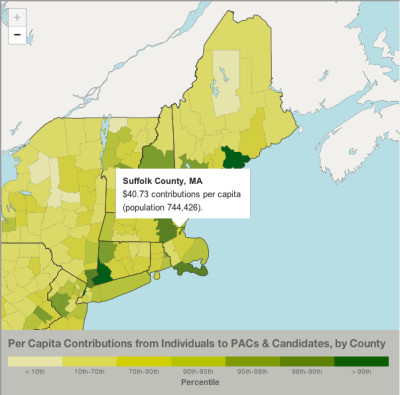 View Larger +
View Larger +
Prev
Next
3. Suffolk County, MA
Contributions, per capita, 2012: $40.73
Total contributions: $30,323,537
Suffolk County has a population of 744,426 and contains Massachusetts’s largest city, Boston. Although Suffolk’s county government was abolished in the late 1900’s, it still remains as a geographic area.
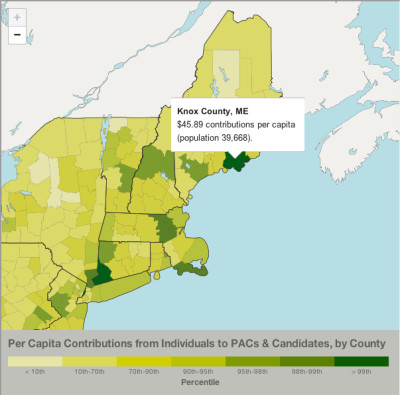 View Larger +
View Larger +
Prev
Next
2. Knox County, ME
Contributions, per capita, 2012: $45.89
Total contributions: $1,820,410
Knox County was established on April 1st, 1860 and was named after American Revolutionary War General Henry Knox. The county has a population of 39,668 and is the home of the Union Fair.
 View Larger +
View Larger +
Prev
Next
1. Fairfield County, CT
Contributions, per capita, 2012: $55.65.
Total contributions: $51,970,701
In a population of 933,835, Fairfield County is the most densely populated county in Connecticut, and contains four of the state's largest cities -- Bridgeport, Stamford, Norwalk and Danbury.
PrevNext
_80_80_90_c1.jpg)
25. Merrimack County, NH
24. Cheshire County, NH
23. Rockingham County, NH
22. Belknap County, NH
21. Hampshire County, MA
20. Barnstable County, MA
19. Berkshire County, MA
18. Essex County, MA
17. Chittendon County, VT
16. Lamoille County, VT
15. Addison County, VT
14. Newport County, RI
13. Cumberland County, ME
12. Windsor County, VT
11. Bristol County, RI
10. Grafton County, NH
9. Carrol County, NH
8. LItchfield County, CT_80_80_90_c1.jpg)
7. Middlesex County, MA
6. Nantucket County, MA
5. Norfolk County, MA
4. Dukes County, MA
3. Suffolk County, MA
2. Knox County, ME
1. Fairfield County, CT
Related Articles
Enjoy this post? Share it with others.




_400_395_90.jpg)

















_400_395_90.jpg)






_80_80_90_c1.jpg)

















_80_80_90_c1.jpg)






